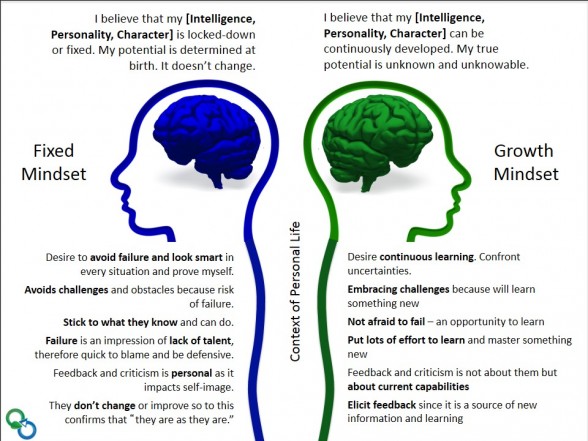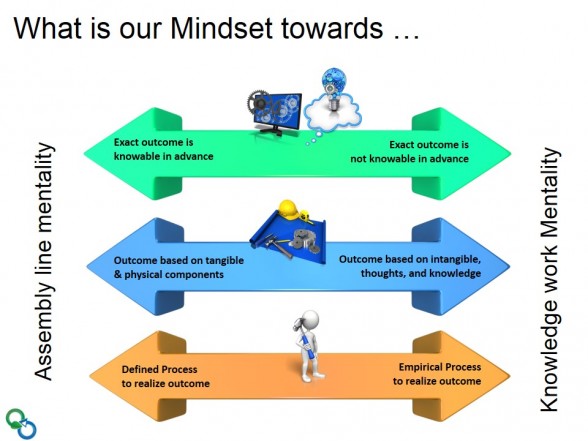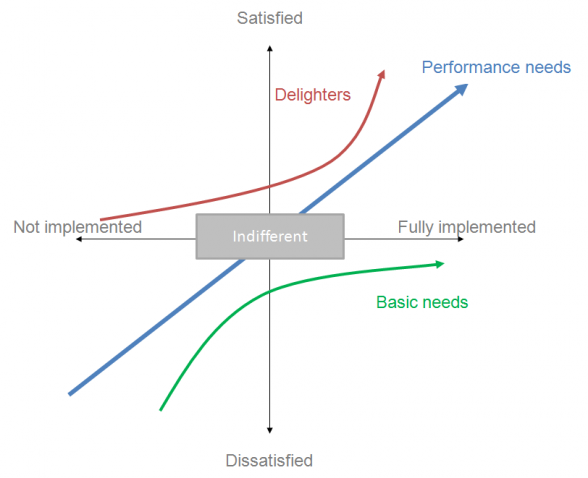Reflections on attending The Agile Mindset Masterclass
Last week I sat on the other side of the classroom for a pleasant change, I attended the Masterclass by Ahmed Sidky “CHANGING THE MINDSET: Achieving Organisational Agility” in Melbourne. It was a great two days, with a fantastic group of participants. Together we examined what it means to really BE Agile, rather than just doing the Agile practices.
Ahmed is an inspiring and engaging presenter – he grabbed our attention from the very first activity and presented us with a series of pearls of wisdom reinforced by experiential exercises and deep discussions where the participants were able to apply the new knowledge to our own environment and context.
For me, the underlying message of the class is the importance of the mindset shift needed from an industrial-age “fixed” perspective to a knowledge era “growth” perspective. He presented the following diagram to show the differences:

He then asked us to think about the nature of work and presented a set of three sliders showing the dimensions which impact the way work gets done, the ability to predict outcomes and the type of process which can be used to deliver business value.

He had us thinking deeply about different project profiles and the nature of work in our organisations.
Over the two days I wrote down some of the key points he made:
- Where there are no constraints, there is no agility
- While it is possible to do Agile without being Agile – that won’t allow you to achieve the organisational and team benefits that being Agile can give you
- Being Agile is all about constant Learning and Discovery
- The key to constantly delivering business benefits is creating an environment of trust
- In today’s business environment the boundary is moving from scope to time, yet we still try and manage as if scope if the boundary – knowledge work is never done
- There are plenty more – but that’s probably enough for this post
He explained the Kano model for identifying which features should be in a product.

He explained the importance of having a set of features which meet the customers Basic and Performance needs, however, opportunity comes from the Delighters – those factors which create a unique competitive advantage and true customer delight. The Agile process of learning and discovery enables rapid feedback and helps teams identify what makes the right product.
He went on to talk about the structure of teams, and how great products need two overlapping and complementary teams – what he calls the Delivery and the Value teams. The Delivery team contains all the skills and knowledge needed to build the product, and the Value team has all the skills and knowledge needed to identify what the product must contain.
On small projects, there may be a single Value representative, but in the vast majority of organisations today the concept of a single “Product Owner” who knows everything and can make all the needed decisions just doesn’t happen. The Value team are there to bring the various viewpoints together and liaise across the stakeholder community, understanding governance, IV&V, user experience and other factors which influence what value actually means in the context of the specific product and organisational environment.
These two days were great for me – I really enjoyed working with my fellow participants and learning from a true Master of his content.
We will be bringing Ahmed back to Australia and New Zealand next year – I strongly recommend this class to anyone looking to understand what it takes to truly BE Agile.
Thank you Ahmed, and thank you, my fellow participants!
Posted by Shane Hastie
Thank you!
Your details have been submitted and we will be in touch.